Fun with fins and feathers
Cast-and-blast trips are a great way to combine fishing and hunting excursions during the autumn season to maximize the outdoors experience
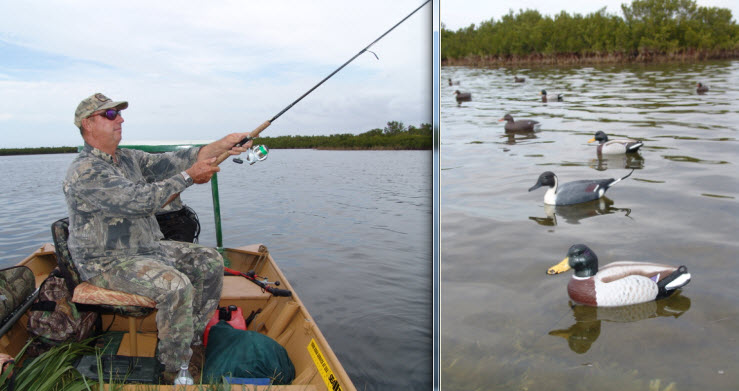
It’s a double dip of outdoor fun – a straight up sportsman’s overload with a best-of-both-worlds vibe. A popular pastime throughout the Gulf region, it’s the venerable cast-and-blast trip, where shotguns and fishing rods share space and equal merit.
Consider how many times a flight of ducks has distracted your casting. Conversely, how often do duck hunters ponder the fishability of waters over which they shoot? On many fall mornings, the day’s objective comes down to coin toss: fins or feathers?
However, with proper planning and a little strategy, sportsmen can pocket that coin and enjoy a satisfying mix of casting and blasting. Popular duck species include open water divers like lesser scaup (“bluebills”), canvasbacks, redheads, and ring-necks, along with dabblers (aka “puddle ducks”) such as mallards, teal, widgeon, shovelers and pintails. On the fishing side, targets of opportunity may range from flounder to grouper, but throughout the Gulf, targeting redfish and speckled trout will keep you in the game.
When and where
Cast-and-blast trips owe their fame to Southeastern Louisiana – particularly the Mississippi Delta, where vast acreage of coastal marsh offers abundant habitat for fish and fowl. (Despite the oil spill disaster, much of Louisiana’s marsh remains open for hunting and fishing.)
Launching from towns such as Port Sulfur, Empire, Buras, and Venice, cast-and-blasters generally focus on bayous and shallow enclosed areas known as “duck ponds.” Ideal ponds have good tidal flow, smaller Roseau cane islands and oyster reefs that hold baitfish and keep the water clean. On falling tides, exterior run-out creeks attract reds and trout, which stage on the adjacent flats to gobble departing forage.
Sportsmen find similar attributes in Alabama’s Mobile Bay region, particularly in the Mobile-Tensaw River Delta. A smattering of bayous, creeks and small bays presents promising habit for lining up your sights or lining up a cast.
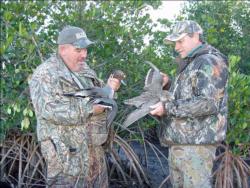 In Florida’s Big Bend, the west side of Apalachicola Bay offers prime multi-tasking habitat, while farther south, the coastline from Ozello to Homosassa presents exceptional opportunity amid a labyrinth of countless islands and nameless keys. Continuing down the Sunshine State, Tampa Bay’s mix of expansive open waters and protected creeks and coves give hunters convenient access to diving and puddle ducks, as well as bountiful angling opportunities.
In Florida’s Big Bend, the west side of Apalachicola Bay offers prime multi-tasking habitat, while farther south, the coastline from Ozello to Homosassa presents exceptional opportunity amid a labyrinth of countless islands and nameless keys. Continuing down the Sunshine State, Tampa Bay’s mix of expansive open waters and protected creeks and coves give hunters convenient access to diving and puddle ducks, as well as bountiful angling opportunities.
Wherever they hunt, serious waterfowlers know that chilly, damp weather equals excellent duck hunting. In fact, southern hunters revel in reports of northern ice storms that will surely push another wave of migratory ducks southward. In truth, it’s rare for ideal hunting and fishing conditions to coincide, but Homosassa guide, Capt Mike Locklear (www.homosassafishing.com) said preparation allows him to capitalize on windows of opportunity.
“Waterfowling and fishing are similar in that you have to take what hand you are dealt by God Himself,” said Locklear. “I make myself ready at all times and call my clients when the ducks are flying or the fish are biting.”
Summarily, calm, “pretty” days allow ducks to feed farther from shore and stay out of range until they fly in to roost at sundown. Seasoned hunters like blustery days because choppy conditions keep the birds tighter to the coast. For a good balance of hunting and fishing success, pick the overcast days before a cold front, or at least mostly cloudy conditions. Anything but a bright bluebird sky – that usually stinks for fishing and ducks can spot hunters from greater distances.
Capt. Anthony Randazzo, who runs cast-and-blast trips out of Paradise Plus Lodge (www.paradise-plus.com) in Venice, La., notes that the extremely low tides common in fall/winter seasons present a major logistical consideration. “The high tide (stage) is necessary for navigation, but more importantly for having enough water to float the decoys. Also, the birds will move closer to shore on the high tide rather than rafting in open water or along deep channels at low tide.”
Transportation and concealment
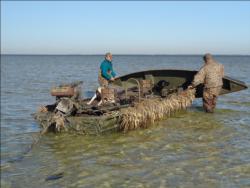 In open water, hunters shoot diving ducks mostly from camouflaged aluminum boats with pop-up blinds. For puddle duck hunts, you’ll cross whisper-thin water to reach the hunting spot, so flat bottom John boats with long shaft outdrives like the Go Devil are the way to go. Duck boats typically lack the speed and range of high-tech flats skiffs and bay boats, but given the season’s lower tides, you won’t have to go far to find a pile of fish congregated in a low water refuge.
In open water, hunters shoot diving ducks mostly from camouflaged aluminum boats with pop-up blinds. For puddle duck hunts, you’ll cross whisper-thin water to reach the hunting spot, so flat bottom John boats with long shaft outdrives like the Go Devil are the way to go. Duck boats typically lack the speed and range of high-tech flats skiffs and bay boats, but given the season’s lower tides, you won’t have to go far to find a pile of fish congregated in a low water refuge.
Puddle duck hunters motor into their general target areas and then wade to the blind, or paddle in with a narrow, canoe-like boat called a pirogue (“peer-o”). Erecting permanent blinds over firm shoreline is not uncommon, but in muddy areas of tall, thin reeds or Louisiana’s Roseau cane, hunters ram their pirogues into a patch of vegetation and create natural blinds by bending the stalks down to shoulder level. Crouching low in the pirogue hides you from approaching birds. When your quarry flies into range, just stand up and shoot.
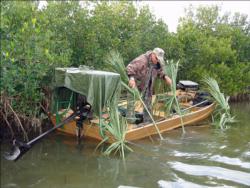 Florida hunters fashion their impromptu blinds by setting camp chairs under or amid the mangrove trees. In any natural blind, augmenting the local vegetation with cammo netting and cabbage palm fronds or bamboo cane enhances your concealment. Camouflage clothing, hats and gloves, along with either cammo face masks or face paint lessens the chances of sharp-eyed ducks spotting danger.
Florida hunters fashion their impromptu blinds by setting camp chairs under or amid the mangrove trees. In any natural blind, augmenting the local vegetation with cammo netting and cabbage palm fronds or bamboo cane enhances your concealment. Camouflage clothing, hats and gloves, along with either cammo face masks or face paint lessens the chances of sharp-eyed ducks spotting danger.
Given the damp, muddy environment, you’ll appreciate neoprene chest waders, even if fall temperatures remain mild. Just consider that mud will grip boot-foot waders and send hunters tumbling when their feet slip up the leg. Avoid this with a stocking foot design and a pair of sturdy wading boots two sizes larger than your shoes to accommodate the extra bulk. Before or after hunting, those waders provide the option of fishing on foot.
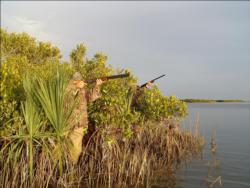 When hunting from shore or in a pirogue, avoid spooking your quarry by stashing the duck boat well away from your shooting lane and covering it with a cammo tarp and indigenous foliage. Of course, the one thing your feathered quarry won’t shy away from is other ducks – even the imposters. Animals know there’s strength in numbers, so arrange a generous field of decoys, grouped by species and arranged with a clear landing zone directly in front of your field of fire.
When hunting from shore or in a pirogue, avoid spooking your quarry by stashing the duck boat well away from your shooting lane and covering it with a cammo tarp and indigenous foliage. Of course, the one thing your feathered quarry won’t shy away from is other ducks – even the imposters. Animals know there’s strength in numbers, so arrange a generous field of decoys, grouped by species and arranged with a clear landing zone directly in front of your field of fire.
When ducks appear overhead, combining authentic calls with the visual appeal of decoys often convinces the birds to take a breather. Hold your fire until you see the ducks “flare” their wings and drop their landing gear. Rise too quickly and agile ducks can veer away from the decoy field.
On the flipside, Locklear said waiting too long creates a proximity hazard: “I hate it when people shoot my decoys.”
Trip planning
Hunting regulations generally allow shooting from one-half hour before sunrise to sunset (see State-by-state section below). Early mornings and late afternoons are usually best and sportsmen can schedule their cast-and-blast trips around either end of the day. Offering a “Before daylight to dark-thirty” option, Locklear said hardcore types may go sunup to sundown with a long stretch of fishing between the shotgun hours. For most, at least a midday break for lunch keeps everyone rested and sharp.
Randazzo said his guides maximize their time on the water by fishing close to where they hunt. Throughout the Gulf, focusing primarily on redfish facilitates that goal, as reds will push well into brackish and freshwater zones and they’re most likely to feed close to shorelines.
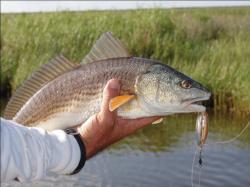 “I prefer to switch passengers between the hunting guides and fishing guides on the water rather than having them return to the marina or the lodge to make the switch,” Randazzo said. “Sometimes we will take customers out of the blind and place them directly into the fishing guide’s boat. The hunters begin fishing quickly while the hunting guides wrap up the gear and clean the ducks back on shore. However, we do whatever it takes to put fish/ducks in the boat.”
“I prefer to switch passengers between the hunting guides and fishing guides on the water rather than having them return to the marina or the lodge to make the switch,” Randazzo said. “Sometimes we will take customers out of the blind and place them directly into the fishing guide’s boat. The hunters begin fishing quickly while the hunting guides wrap up the gear and clean the ducks back on shore. However, we do whatever it takes to put fish/ducks in the boat.”
Helpful in getting ducks to the boat is a well-trained Labrador or golden retriever that will reach fallen waterfowl before the tide displaces them. This is particularly important in the low light of afternoon hunts when drifting birds can vanish amid the waves. Lacking a dog, Locklear suggests a spinning rod with a weighted treble hook. Accurate casting enables a hunter to retrieve birds remotely.
During the trip, pay attention to your surrounding and you’ll pick up cues for the casting while you’re blasting and vice versa. Between fish, scan the sky and note when and where ducks fly. Likewise, when approaching your shooting spots, take note of prominent rocks, oyster colonies, sand bars, deep cuts and drains. All influence fish positioning, so make a mental note, mark a chart or just snap a cell phone picture. If you opt for digital images, be sure to save plenty of memory for the yield of your casting and blasting.
State-by-state
Find state hunting and fishing regulations at:
Texas: www.tpwd.state.tx.us/
Louisiana: www.wlf.louisiana.gov/
Mississippi: http://home.mdwfp.com/Default.aspx
Alabama: www.outdooralabama.com/
Florida: www.myfwc.com